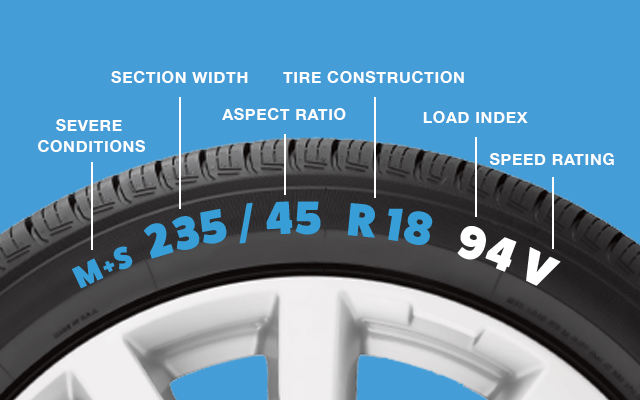Tire Speed Rating Codes: What They Mean
Tire speed rating codes are one of several important codes to pay attention to when you’re buying new or different tires. Let’s go over what they are, what they mean, whether they’re important and what to choose with our handy speed rating chart.
What does “speed rating” mean on tires?
The speed rating on a tire indicates the fastest speed a tire can handle before it affects the tire’s performance. Lower speed ratings (such as A8 or B) will mean that you won’t have good control or handling of the car at highway speeds. Higher speed ratings, like H or ZR, can handle far beyond a normal highway speed. For example, “H” would translate to a tire that can only handle speeds up to 130 mph (or 210 km/h).
Where is the speed rating located on a tire?
You can find a tire’s speed rating on the sidewall, where one will typically see a string of numbers and letters. These are several important codes, such as radial construction, aspect ratio, tire load and speed rating. The speed rating is typically the last letter listed on the sidewall (coming after the load index, which is a number). For example, if you see “M+S 235/45 R18 94V” on the side of the tire, the last letter, V, is your speed rating.
If you can’t find the last letter printed on the sidewall of your tire because it’s worn off or hard to find, you can also find your vehicle’s recommended tire specs in your car’s manual.
What do the letters mean?
Speed ratings go from A1 to Y, with A1 having the lowest rating and Y being the highest, but there are some anomalies. There are eight different A ratings. There are no X, O, or I ratings, and H rating is in the “wrong” place. Also, the ZR rating isn’t truly its own rating, but includes both W- and Y-rated tires. You’ll want to use our chart to find out which letter matches which speed.
Does tire speed rating matter?
Yes, it matters because your speed rating indicates how much heat a tire can handle safely. Not following those guidelines can lead to faster wear on the tread, decreased steering response, decreased stopping power and poor driving capabilities in colder conditions. Tire manufacturers conduct tests to meet the Society of Automotive Engineer’s standards, running the tire for a full hour in a machine in a room that’s heated to 100 degrees. This testing is done in a controlled environment, however, and so many other variables might affect your tire’s safety, like the size of the load, the weather and the wear. Since it can have an impact on your stopping power, a tire’s speed rating is not the tire rating code to ignore.
What are the most common tire speed ratings?
Most commuters and consumers will want either an H, S or T tire. Light trucks may need a tire between the N and T ratings. Sports cars may get better handling with a ZR tire.
- H-Rated Tires: This is a perfect, average tire for most sedans and commuter vehicles. It might not seem to fit in our chart, but the tire speed rating “H” is rated for up to 130 mph.
- T-Rated Tires: This tire is often recommended for family sedans and vans. It’s rated for up to 118 mph. That’s well below the speed limit of most states, unless you’re planning on bringing your commuter on the Autobahn.
- ZR-Rated Tires: The ZR rating (or Z rating) indicates anything above the V rating (168 mph), so it includes both the Y and W speed rating. Sports cars will often get the best handling with these tires.
It’s not necessarily the case that the higher the speed rating, the better the tire; there are exceptions. For instance, many off-roading tires are powerful and girthy, working perfectly in mud and sand, but they might only have a speed rating of L, meaning that you’ll not want to bring those tires on the highway.
Tire Speed Rating Chart
|
Speed Rating Symbol |
Speed (mph) |
Speed (km/h) |
|
A1-A8 |
<25 mph |
<40 km/h |
|
B |
31 mph |
50 km/h |
|
C |
37 mph |
60 km/h |
|
D |
40 mph |
65 km/h |
|
E |
43 mph |
70 km/h |
|
F |
50 mph |
80 km/h |
|
G |
56 mph |
90 km/h |
|
J |
62 mph |
100 km/h |
|
K |
68 mph |
110 km/h |
|
L |
75 mph |
120 km/h |
|
M |
81 mph |
130 km/h |
|
N |
87 mph |
140 km/h |
|
P |
94 mph |
150 km/h |
|
Q |
100 mph |
160 km/h |
|
R |
106 mph |
170 km/h |
|
S |
112 mph |
180 km/h |
|
T |
118 mph |
190 km/h |
|
U |
124 mph |
200 km/h |
|
H |
130 mph |
210 km/h |
|
V |
149 mph |
240 km/h |
|
ZR |
Above 168 mph |
Above 270 km/h |
|
W |
168 mph |
270 km/h |
|
Y |
186 mph |
300 km/h |
|
(Y) |
Above 186 mph |
Above 300 km/h |
If all of this still sounds like Greek to you, feel free to connect TIRE OUTLET, and we can help you pick out a tire with the speed rating that meets your needs. Schedule your appointment for brand new tires today!"


